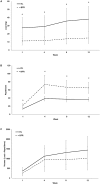Progression of Blood Flow Restricted Resistance Training in Older Adults at Risk of Mobility Limitations
- PMID: 31249534
- PMCID: PMC6582311
- DOI: 10.3389/fphys.2019.00738
Progression of Blood Flow Restricted Resistance Training in Older Adults at Risk of Mobility Limitations
Abstract
Blood flow restriction (BFR) resistance training leads to increased muscle mass and strength but the progression leading to adaptations may be different as strength gains are often to a lesser magnitude than high-load (HL) training. The impact of training loads and repetitions on older adults' muscle mass and strength following BFR or HL training was evaluated. Twenty-one older adults (67-90 years) classified as being at risk of mobility limitations were randomly assigned to HL (n = 11) or BFR (n = 10) knee extension (KE) and flexion (KF) training twice per week for 12 weeks. Strength was measured with 10-repetition maximum (10-RM) tests and isometric contractions. Cross-sectional area (CSA) of the quadriceps and hamstrings was measured. HL and BFR interventions increased 10-RM KF and isometric strength (P < 0.05) and hamstrings CSA increased an average of 4.8 ± 5.9% after HL and BFR training (time main effect P < 0.01). There were no differences between the training groups (time x group interactions P > 0.05). The rate of progression of KF training load and repetitions was comparable (time × group interactions of each variable P > 0.05). The groups averaged an increase of 0.50 ± 25 kg⋅week-1 and 1.8 ± 0.1.7 repetitions⋅week-1 of training (time main effects P < 0.05). The HL training group experienced greater improvements in KE 10-RM strength than the BFR group (60.7 ± 36.0% vs. 35.3 ± 25.5%; P = 0.03). In both groups, isometric KE strength increased 17.3 ± 18.5% (P = 0.001) and there were no differences between groups (P = 0.24). Quadriceps CSA increased (time main effect P < 0.01) and to similar magnitudes (time x group interaction P = 0.62) following HL (6.5 ± 3.1%) and BFR training (7.8 ± 8.2%). The HL group experienced accelerated progression of load when compared to BFR (0.90 ± 0.60 kg⋅week-1 vs. 30 ± 0.21 kg⋅week-1; P = 0.006) but was not different when expressed in relative terms. BFR training progressed at a rate of 3.6 ± 1.3 repetitions⋅week-1 while the HL group progressed at 2.2 ± 0.43 repetitions⋅week-1 (P = 0.003). HL training led to greater increases in KE 10-RM and it may be attributed to the greater load and/or faster rate of progression of the load throughout the 12-week training period and the specificity of the testing modality. Incorporating systematic load progression throughout BFR training periods should be employed to lead to maximal strength gains.
Keywords: blood flow restriction; hypertrophy; older adults; progression; resistance training.
Figures


Similar articles
-
Blood flow restricted resistance training in older adults at risk of mobility limitations.Exp Gerontol. 2017 Dec 1;99:138-145. doi: 10.1016/j.exger.2017.10.004. Epub 2017 Oct 5. Exp Gerontol. 2017. PMID: 28987643 Free PMC article. Clinical Trial.
-
Effects of alternating blood flow restricted training and heavy-load resistance training on myofiber morphology and mechanical muscle function.J Appl Physiol (1985). 2020 Jun 1;128(6):1523-1532. doi: 10.1152/japplphysiol.00015.2020. Epub 2020 Apr 23. J Appl Physiol (1985). 2020. PMID: 32324471 Clinical Trial.
-
Muscle Adaptations to Heavy-Load and Blood Flow Restriction Resistance Training Methods.Front Physiol. 2022 Feb 3;13:837697. doi: 10.3389/fphys.2022.837697. eCollection 2022. Front Physiol. 2022. PMID: 35185627 Free PMC article.
-
Potential Moderators of the Effects of Blood Flow Restriction Training on Muscle Strength and Hypertrophy: A Meta-analysis Based on a Comparison with High-Load Resistance Training.Sports Med Open. 2024 May 22;10(1):58. doi: 10.1186/s40798-024-00719-3. Sports Med Open. 2024. PMID: 38773002 Free PMC article.
-
Muscle strength adaptation between high-load resistance training versus low-load blood flow restriction training with different cuff pressure characteristics: a systematic review and meta-analysis.Front Physiol. 2023 Aug 25;14:1244292. doi: 10.3389/fphys.2023.1244292. eCollection 2023. Front Physiol. 2023. PMID: 37693006 Free PMC article.
Cited by
-
Effect of blood-flow restricted vs heavy-load resistance training on strength, power, and speed for healthy volunteers: a systematic review and meta-analysis.PeerJ. 2025 Mar 18;13:e19110. doi: 10.7717/peerj.19110. eCollection 2025. PeerJ. 2025. PMID: 40124607 Free PMC article.
-
Effects of exercise therapy with blood flow restriction on shoulder strength: protocol for a systematic review and meta-analysis.BMJ Open. 2025 Apr 9;15(4):e097640. doi: 10.1136/bmjopen-2024-097640. BMJ Open. 2025. PMID: 40204304 Free PMC article.
-
Effects of Blood Flow Restriction Combined with Low-Intensity Resistance Training on Lower-Limb Muscle Strength and Mass in Post-Middle-Aged Adults: A Systematic Review and Meta-Analysis.Int J Environ Res Public Health. 2022 Nov 25;19(23):15691. doi: 10.3390/ijerph192315691. Int J Environ Res Public Health. 2022. PMID: 36497769 Free PMC article.
-
The effects of upper body blood flow restriction training on muscles located proximal to the applied occlusive pressure: A systematic review with meta-analysis.PLoS One. 2023 Mar 23;18(3):e0283309. doi: 10.1371/journal.pone.0283309. eCollection 2023. PLoS One. 2023. PMID: 36952451 Free PMC article.
-
Comparison of blood flow restriction training and conventional resistance training for the improvement of sarcopenia in the older adults: A systematic review and meta-analysis.Sports Med Health Sci. 2022 Dec 17;5(4):269-276. doi: 10.1016/j.smhs.2022.12.002. eCollection 2023 Dec. Sports Med Health Sci. 2022. PMID: 38314044 Free PMC article. Review.
References
-
- Abramoff M., Magalhaes P., Ram S. (2004). Image processing with ImageJ. Biophotonics Int. 11 36–42.
LinkOut - more resources
Full Text Sources

